Labour Market Impact on the Aviation Industry: A Qantas Case Study
VerifiedAdded on 2020/06/06
|8
|2474
|173
Report
AI Summary
This report provides a comprehensive analysis of the labour market trends within the aviation industry, with a specific focus on Qantas airlines. It begins with an introduction to the labour market and its impact on various industries. The report then delves into the analysis of statistics and factors affecting the aviation industry, including technology, global conflicts, airport growth, and fuel prices. A detailed examination of Qantas airlines follows, outlining factors that have influenced its performance, such as cost-cutting measures, international competition, and changes in oil prices. The report further explores factors that could affect Qantas in the future, including social media and increasing distribution channels. An investigation interview with a Qantas manager is included to gather insights on labour market information, supply, and current changes, such as de-industrialization and the growth of the service sector. The report concludes by summarizing the key findings and emphasizing the significance of labour market trends for the aviation industry.
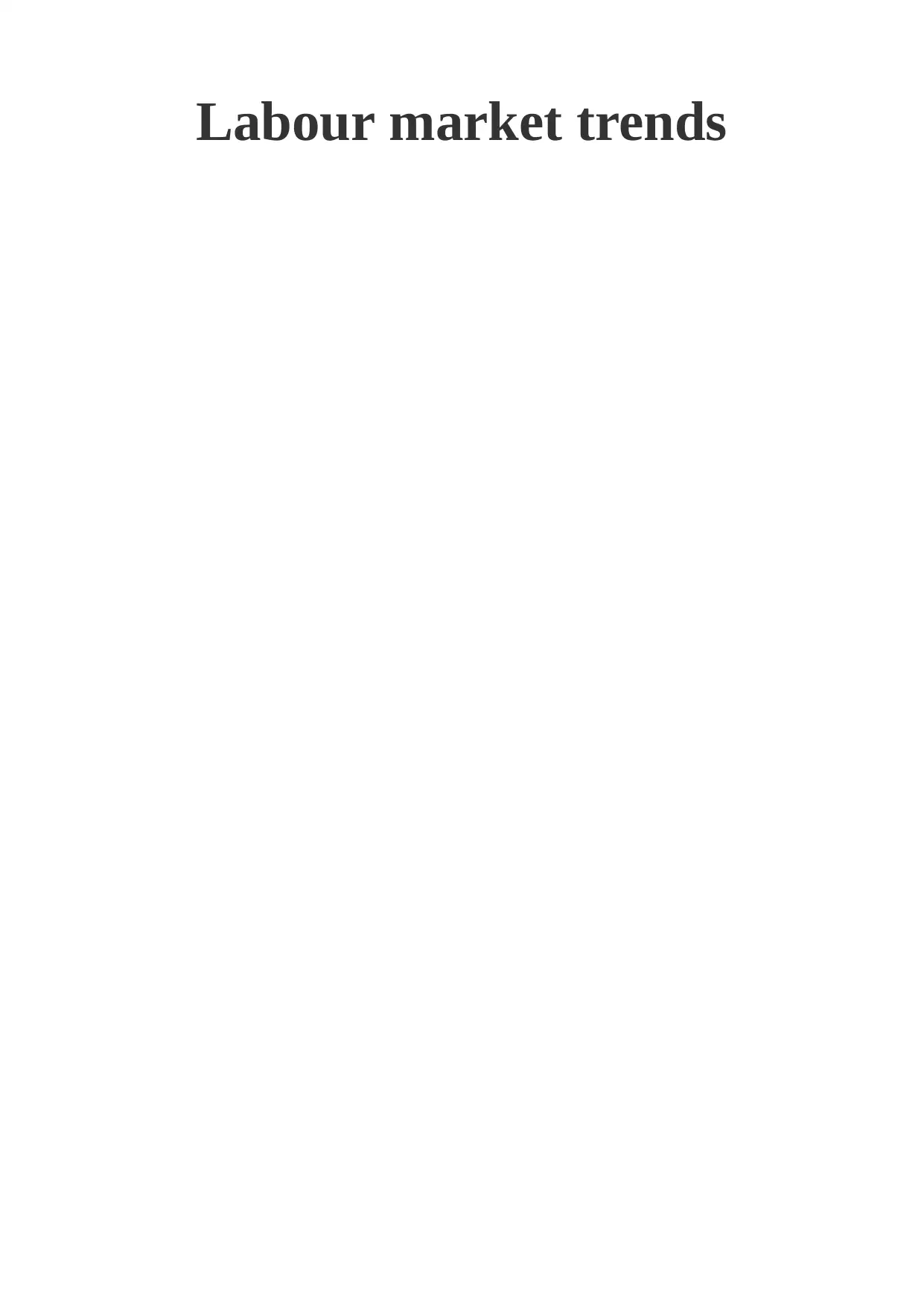
Labour market trends
Paraphrase This Document
Need a fresh take? Get an instant paraphrase of this document with our AI Paraphraser
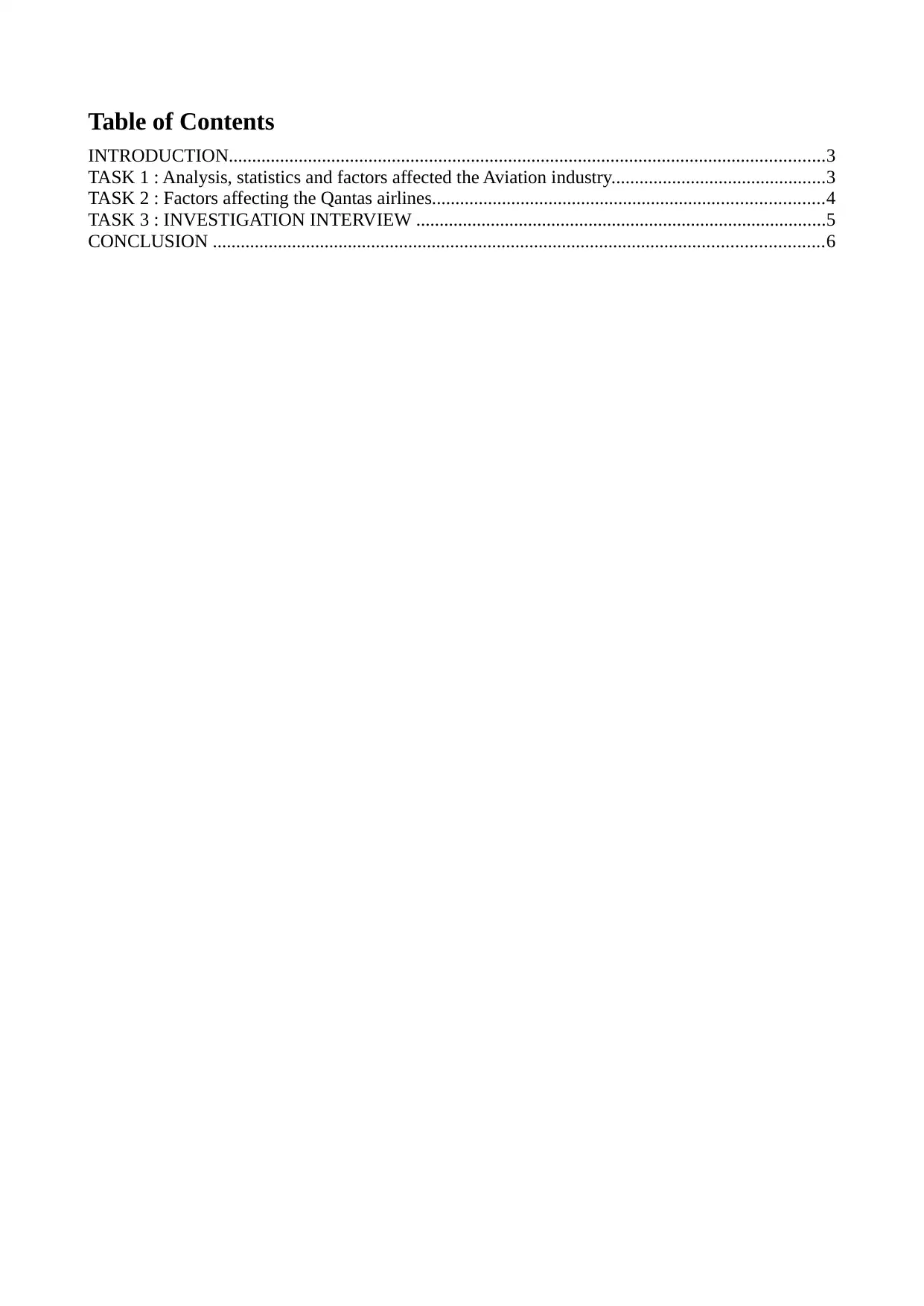
Table of Contents
INTRODUCTION................................................................................................................................3
TASK 1 : Analysis, statistics and factors affected the Aviation industry..............................................3
TASK 2 : Factors affecting the Qantas airlines....................................................................................4
TASK 3 : INVESTIGATION INTERVIEW ........................................................................................5
CONCLUSION ...................................................................................................................................6
INTRODUCTION................................................................................................................................3
TASK 1 : Analysis, statistics and factors affected the Aviation industry..............................................3
TASK 2 : Factors affecting the Qantas airlines....................................................................................4
TASK 3 : INVESTIGATION INTERVIEW ........................................................................................5
CONCLUSION ...................................................................................................................................6
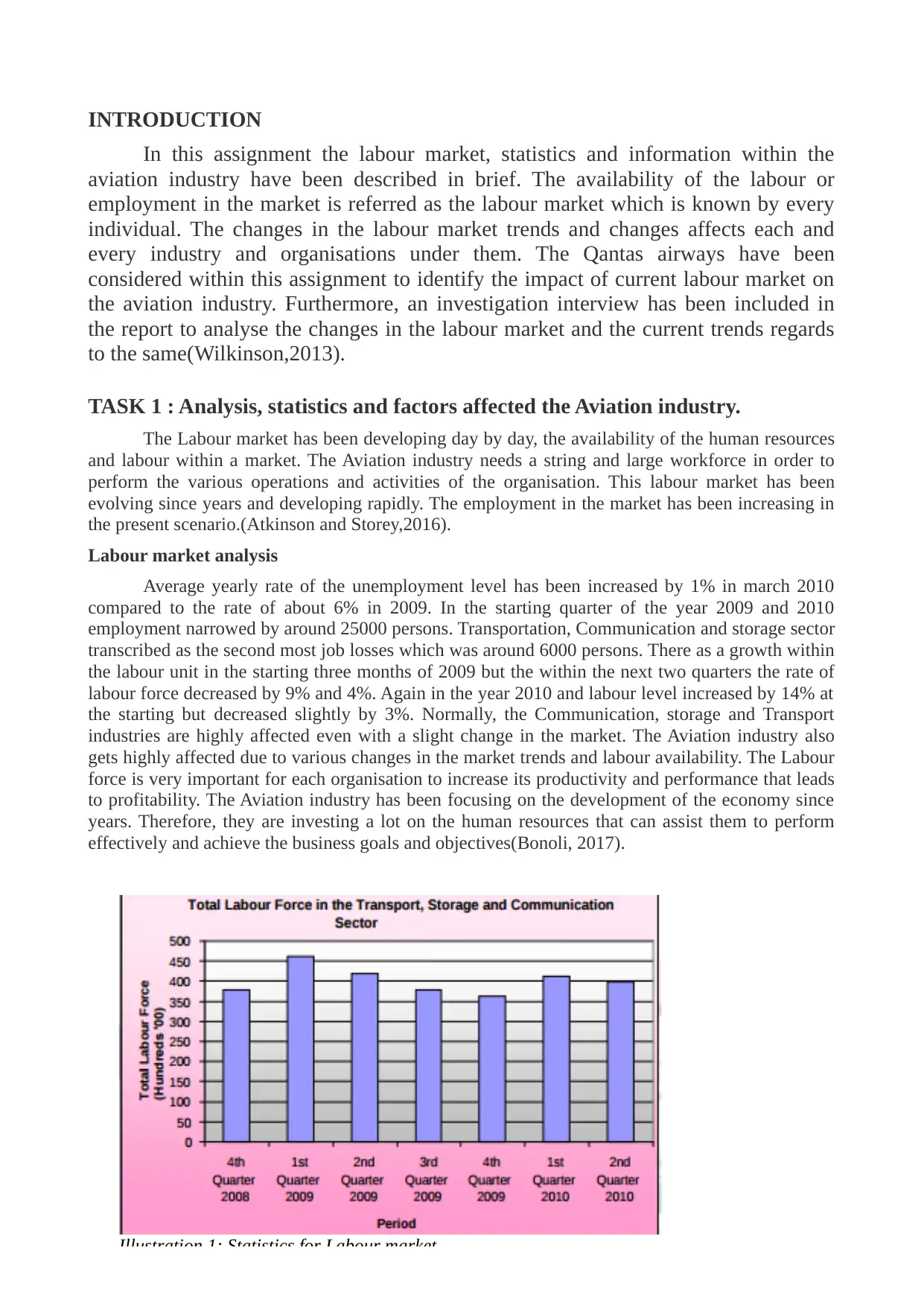
INTRODUCTION
In this assignment the labour market, statistics and information within the
aviation industry have been described in brief. The availability of the labour or
employment in the market is referred as the labour market which is known by every
individual. The changes in the labour market trends and changes affects each and
every industry and organisations under them. The Qantas airways have been
considered within this assignment to identify the impact of current labour market on
the aviation industry. Furthermore, an investigation interview has been included in
the report to analyse the changes in the labour market and the current trends regards
to the same(Wilkinson,2013).
TASK 1 : Analysis, statistics and factors affected the Aviation industry.
The Labour market has been developing day by day, the availability of the human resources
and labour within a market. The Aviation industry needs a string and large workforce in order to
perform the various operations and activities of the organisation. This labour market has been
evolving since years and developing rapidly. The employment in the market has been increasing in
the present scenario.(Atkinson and Storey,2016).
Labour market analysis
Average yearly rate of the unemployment level has been increased by 1% in march 2010
compared to the rate of about 6% in 2009. In the starting quarter of the year 2009 and 2010
employment narrowed by around 25000 persons. Transportation, Communication and storage sector
transcribed as the second most job losses which was around 6000 persons. There as a growth within
the labour unit in the starting three months of 2009 but the within the next two quarters the rate of
labour force decreased by 9% and 4%. Again in the year 2010 and labour level increased by 14% at
the starting but decreased slightly by 3%. Normally, the Communication, storage and Transport
industries are highly affected even with a slight change in the market. The Aviation industry also
gets highly affected due to various changes in the market trends and labour availability. The Labour
force is very important for each organisation to increase its productivity and performance that leads
to profitability. The Aviation industry has been focusing on the development of the economy since
years. Therefore, they are investing a lot on the human resources that can assist them to perform
effectively and achieve the business goals and objectives(Bonoli, 2017).
Illustration 1: Statistics for Labour market
In this assignment the labour market, statistics and information within the
aviation industry have been described in brief. The availability of the labour or
employment in the market is referred as the labour market which is known by every
individual. The changes in the labour market trends and changes affects each and
every industry and organisations under them. The Qantas airways have been
considered within this assignment to identify the impact of current labour market on
the aviation industry. Furthermore, an investigation interview has been included in
the report to analyse the changes in the labour market and the current trends regards
to the same(Wilkinson,2013).
TASK 1 : Analysis, statistics and factors affected the Aviation industry.
The Labour market has been developing day by day, the availability of the human resources
and labour within a market. The Aviation industry needs a string and large workforce in order to
perform the various operations and activities of the organisation. This labour market has been
evolving since years and developing rapidly. The employment in the market has been increasing in
the present scenario.(Atkinson and Storey,2016).
Labour market analysis
Average yearly rate of the unemployment level has been increased by 1% in march 2010
compared to the rate of about 6% in 2009. In the starting quarter of the year 2009 and 2010
employment narrowed by around 25000 persons. Transportation, Communication and storage sector
transcribed as the second most job losses which was around 6000 persons. There as a growth within
the labour unit in the starting three months of 2009 but the within the next two quarters the rate of
labour force decreased by 9% and 4%. Again in the year 2010 and labour level increased by 14% at
the starting but decreased slightly by 3%. Normally, the Communication, storage and Transport
industries are highly affected even with a slight change in the market. The Aviation industry also
gets highly affected due to various changes in the market trends and labour availability. The Labour
force is very important for each organisation to increase its productivity and performance that leads
to profitability. The Aviation industry has been focusing on the development of the economy since
years. Therefore, they are investing a lot on the human resources that can assist them to perform
effectively and achieve the business goals and objectives(Bonoli, 2017).
Illustration 1: Statistics for Labour market
⊘ This is a preview!⊘
Do you want full access?
Subscribe today to unlock all pages.

Trusted by 1+ million students worldwide
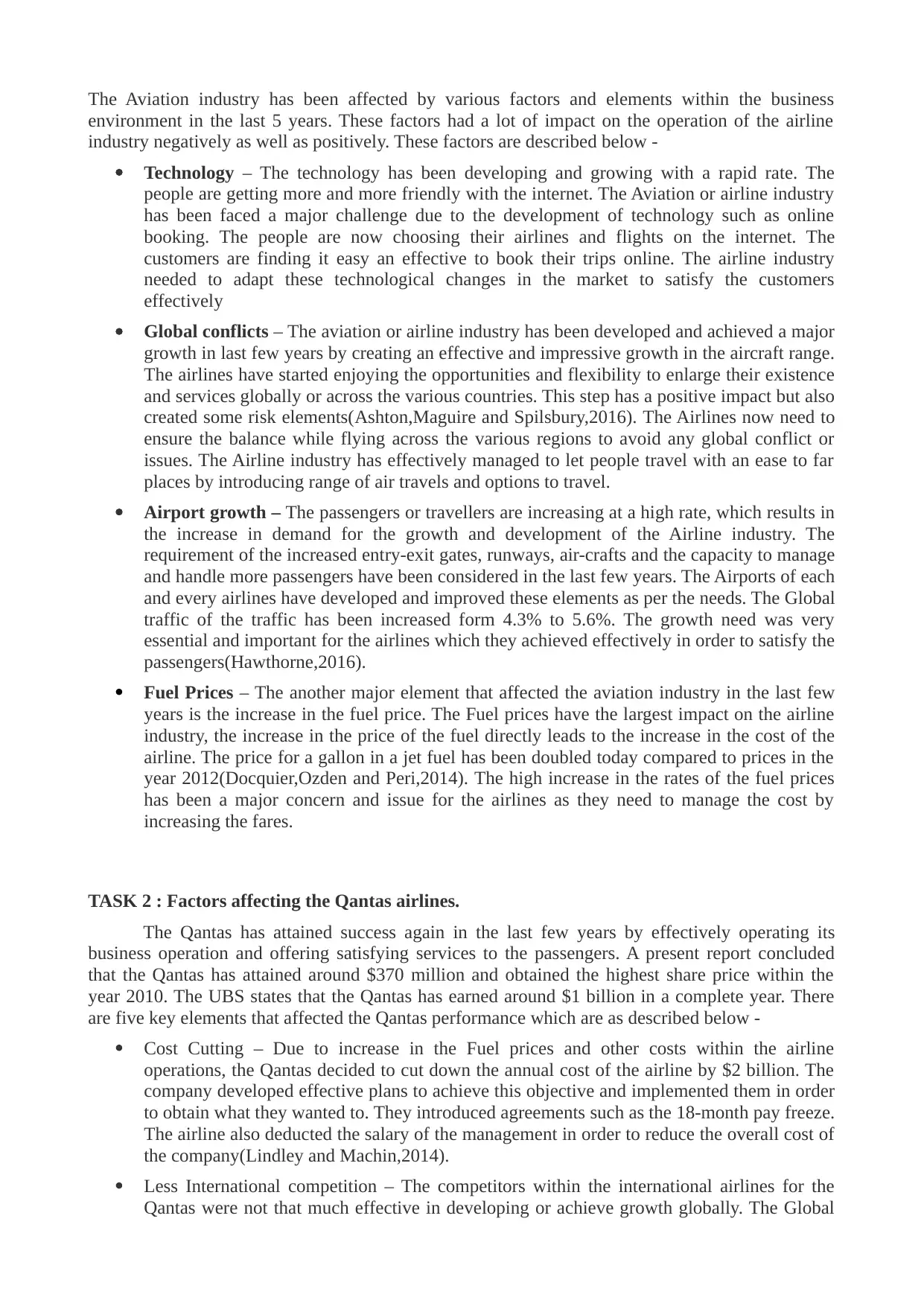
The Aviation industry has been affected by various factors and elements within the business
environment in the last 5 years. These factors had a lot of impact on the operation of the airline
industry negatively as well as positively. These factors are described below -
Technology – The technology has been developing and growing with a rapid rate. The
people are getting more and more friendly with the internet. The Aviation or airline industry
has been faced a major challenge due to the development of technology such as online
booking. The people are now choosing their airlines and flights on the internet. The
customers are finding it easy an effective to book their trips online. The airline industry
needed to adapt these technological changes in the market to satisfy the customers
effectively
Global conflicts – The aviation or airline industry has been developed and achieved a major
growth in last few years by creating an effective and impressive growth in the aircraft range.
The airlines have started enjoying the opportunities and flexibility to enlarge their existence
and services globally or across the various countries. This step has a positive impact but also
created some risk elements(Ashton,Maguire and Spilsbury,2016). The Airlines now need to
ensure the balance while flying across the various regions to avoid any global conflict or
issues. The Airline industry has effectively managed to let people travel with an ease to far
places by introducing range of air travels and options to travel.
Airport growth – The passengers or travellers are increasing at a high rate, which results in
the increase in demand for the growth and development of the Airline industry. The
requirement of the increased entry-exit gates, runways, air-crafts and the capacity to manage
and handle more passengers have been considered in the last few years. The Airports of each
and every airlines have developed and improved these elements as per the needs. The Global
traffic of the traffic has been increased form 4.3% to 5.6%. The growth need was very
essential and important for the airlines which they achieved effectively in order to satisfy the
passengers(Hawthorne,2016).
Fuel Prices – The another major element that affected the aviation industry in the last few
years is the increase in the fuel price. The Fuel prices have the largest impact on the airline
industry, the increase in the price of the fuel directly leads to the increase in the cost of the
airline. The price for a gallon in a jet fuel has been doubled today compared to prices in the
year 2012(Docquier,Ozden and Peri,2014). The high increase in the rates of the fuel prices
has been a major concern and issue for the airlines as they need to manage the cost by
increasing the fares.
TASK 2 : Factors affecting the Qantas airlines.
The Qantas has attained success again in the last few years by effectively operating its
business operation and offering satisfying services to the passengers. A present report concluded
that the Qantas has attained around $370 million and obtained the highest share price within the
year 2010. The UBS states that the Qantas has earned around $1 billion in a complete year. There
are five key elements that affected the Qantas performance which are as described below -
Cost Cutting – Due to increase in the Fuel prices and other costs within the airline
operations, the Qantas decided to cut down the annual cost of the airline by $2 billion. The
company developed effective plans to achieve this objective and implemented them in order
to obtain what they wanted to. They introduced agreements such as the 18-month pay freeze.
The airline also deducted the salary of the management in order to reduce the overall cost of
the company(Lindley and Machin,2014).
Less International competition – The competitors within the international airlines for the
Qantas were not that much effective in developing or achieve growth globally. The Global
environment in the last 5 years. These factors had a lot of impact on the operation of the airline
industry negatively as well as positively. These factors are described below -
Technology – The technology has been developing and growing with a rapid rate. The
people are getting more and more friendly with the internet. The Aviation or airline industry
has been faced a major challenge due to the development of technology such as online
booking. The people are now choosing their airlines and flights on the internet. The
customers are finding it easy an effective to book their trips online. The airline industry
needed to adapt these technological changes in the market to satisfy the customers
effectively
Global conflicts – The aviation or airline industry has been developed and achieved a major
growth in last few years by creating an effective and impressive growth in the aircraft range.
The airlines have started enjoying the opportunities and flexibility to enlarge their existence
and services globally or across the various countries. This step has a positive impact but also
created some risk elements(Ashton,Maguire and Spilsbury,2016). The Airlines now need to
ensure the balance while flying across the various regions to avoid any global conflict or
issues. The Airline industry has effectively managed to let people travel with an ease to far
places by introducing range of air travels and options to travel.
Airport growth – The passengers or travellers are increasing at a high rate, which results in
the increase in demand for the growth and development of the Airline industry. The
requirement of the increased entry-exit gates, runways, air-crafts and the capacity to manage
and handle more passengers have been considered in the last few years. The Airports of each
and every airlines have developed and improved these elements as per the needs. The Global
traffic of the traffic has been increased form 4.3% to 5.6%. The growth need was very
essential and important for the airlines which they achieved effectively in order to satisfy the
passengers(Hawthorne,2016).
Fuel Prices – The another major element that affected the aviation industry in the last few
years is the increase in the fuel price. The Fuel prices have the largest impact on the airline
industry, the increase in the price of the fuel directly leads to the increase in the cost of the
airline. The price for a gallon in a jet fuel has been doubled today compared to prices in the
year 2012(Docquier,Ozden and Peri,2014). The high increase in the rates of the fuel prices
has been a major concern and issue for the airlines as they need to manage the cost by
increasing the fares.
TASK 2 : Factors affecting the Qantas airlines.
The Qantas has attained success again in the last few years by effectively operating its
business operation and offering satisfying services to the passengers. A present report concluded
that the Qantas has attained around $370 million and obtained the highest share price within the
year 2010. The UBS states that the Qantas has earned around $1 billion in a complete year. There
are five key elements that affected the Qantas performance which are as described below -
Cost Cutting – Due to increase in the Fuel prices and other costs within the airline
operations, the Qantas decided to cut down the annual cost of the airline by $2 billion. The
company developed effective plans to achieve this objective and implemented them in order
to obtain what they wanted to. They introduced agreements such as the 18-month pay freeze.
The airline also deducted the salary of the management in order to reduce the overall cost of
the company(Lindley and Machin,2014).
Less International competition – The competitors within the international airlines for the
Qantas were not that much effective in developing or achieve growth globally. The Global
Paraphrase This Document
Need a fresh take? Get an instant paraphrase of this document with our AI Paraphraser
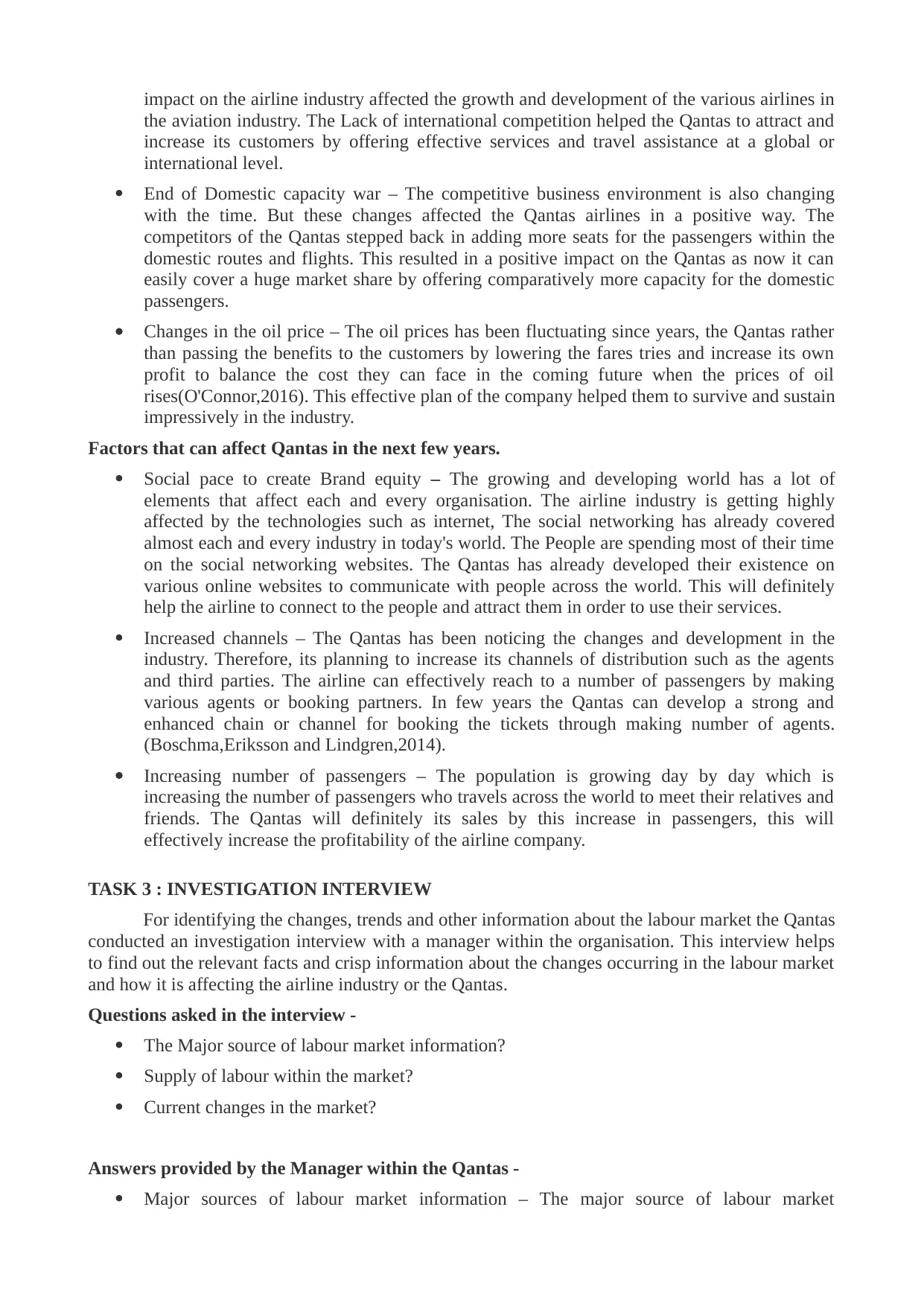
impact on the airline industry affected the growth and development of the various airlines in
the aviation industry. The Lack of international competition helped the Qantas to attract and
increase its customers by offering effective services and travel assistance at a global or
international level.
End of Domestic capacity war – The competitive business environment is also changing
with the time. But these changes affected the Qantas airlines in a positive way. The
competitors of the Qantas stepped back in adding more seats for the passengers within the
domestic routes and flights. This resulted in a positive impact on the Qantas as now it can
easily cover a huge market share by offering comparatively more capacity for the domestic
passengers.
Changes in the oil price – The oil prices has been fluctuating since years, the Qantas rather
than passing the benefits to the customers by lowering the fares tries and increase its own
profit to balance the cost they can face in the coming future when the prices of oil
rises(O'Connor,2016). This effective plan of the company helped them to survive and sustain
impressively in the industry.
Factors that can affect Qantas in the next few years.
Social pace to create Brand equity – The growing and developing world has a lot of
elements that affect each and every organisation. The airline industry is getting highly
affected by the technologies such as internet, The social networking has already covered
almost each and every industry in today's world. The People are spending most of their time
on the social networking websites. The Qantas has already developed their existence on
various online websites to communicate with people across the world. This will definitely
help the airline to connect to the people and attract them in order to use their services.
Increased channels – The Qantas has been noticing the changes and development in the
industry. Therefore, its planning to increase its channels of distribution such as the agents
and third parties. The airline can effectively reach to a number of passengers by making
various agents or booking partners. In few years the Qantas can develop a strong and
enhanced chain or channel for booking the tickets through making number of agents.
(Boschma,Eriksson and Lindgren,2014).
Increasing number of passengers – The population is growing day by day which is
increasing the number of passengers who travels across the world to meet their relatives and
friends. The Qantas will definitely its sales by this increase in passengers, this will
effectively increase the profitability of the airline company.
TASK 3 : INVESTIGATION INTERVIEW
For identifying the changes, trends and other information about the labour market the Qantas
conducted an investigation interview with a manager within the organisation. This interview helps
to find out the relevant facts and crisp information about the changes occurring in the labour market
and how it is affecting the airline industry or the Qantas.
Questions asked in the interview -
The Major source of labour market information?
Supply of labour within the market?
Current changes in the market?
Answers provided by the Manager within the Qantas -
Major sources of labour market information – The major source of labour market
the aviation industry. The Lack of international competition helped the Qantas to attract and
increase its customers by offering effective services and travel assistance at a global or
international level.
End of Domestic capacity war – The competitive business environment is also changing
with the time. But these changes affected the Qantas airlines in a positive way. The
competitors of the Qantas stepped back in adding more seats for the passengers within the
domestic routes and flights. This resulted in a positive impact on the Qantas as now it can
easily cover a huge market share by offering comparatively more capacity for the domestic
passengers.
Changes in the oil price – The oil prices has been fluctuating since years, the Qantas rather
than passing the benefits to the customers by lowering the fares tries and increase its own
profit to balance the cost they can face in the coming future when the prices of oil
rises(O'Connor,2016). This effective plan of the company helped them to survive and sustain
impressively in the industry.
Factors that can affect Qantas in the next few years.
Social pace to create Brand equity – The growing and developing world has a lot of
elements that affect each and every organisation. The airline industry is getting highly
affected by the technologies such as internet, The social networking has already covered
almost each and every industry in today's world. The People are spending most of their time
on the social networking websites. The Qantas has already developed their existence on
various online websites to communicate with people across the world. This will definitely
help the airline to connect to the people and attract them in order to use their services.
Increased channels – The Qantas has been noticing the changes and development in the
industry. Therefore, its planning to increase its channels of distribution such as the agents
and third parties. The airline can effectively reach to a number of passengers by making
various agents or booking partners. In few years the Qantas can develop a strong and
enhanced chain or channel for booking the tickets through making number of agents.
(Boschma,Eriksson and Lindgren,2014).
Increasing number of passengers – The population is growing day by day which is
increasing the number of passengers who travels across the world to meet their relatives and
friends. The Qantas will definitely its sales by this increase in passengers, this will
effectively increase the profitability of the airline company.
TASK 3 : INVESTIGATION INTERVIEW
For identifying the changes, trends and other information about the labour market the Qantas
conducted an investigation interview with a manager within the organisation. This interview helps
to find out the relevant facts and crisp information about the changes occurring in the labour market
and how it is affecting the airline industry or the Qantas.
Questions asked in the interview -
The Major source of labour market information?
Supply of labour within the market?
Current changes in the market?
Answers provided by the Manager within the Qantas -
Major sources of labour market information – The major source of labour market
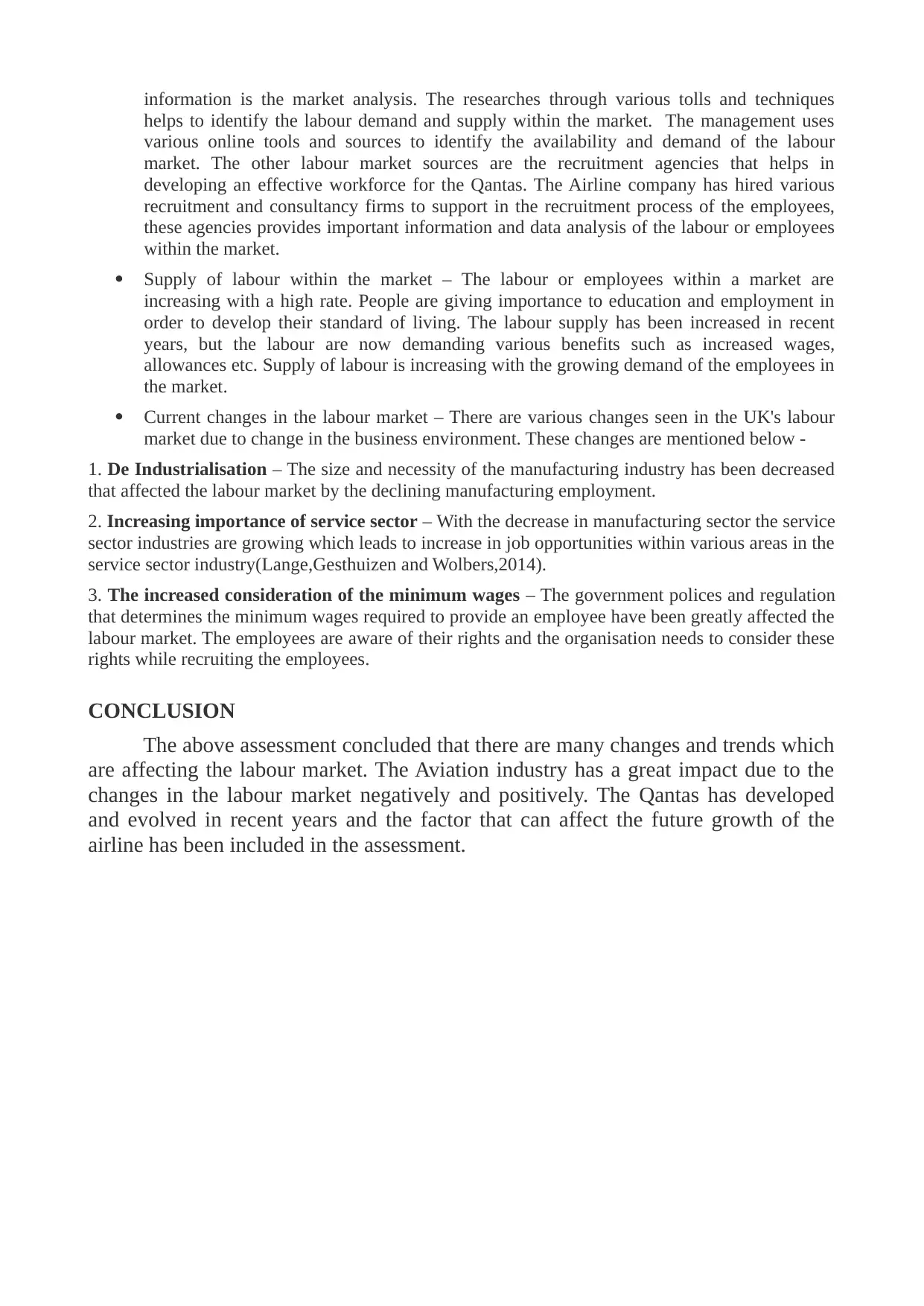
information is the market analysis. The researches through various tolls and techniques
helps to identify the labour demand and supply within the market. The management uses
various online tools and sources to identify the availability and demand of the labour
market. The other labour market sources are the recruitment agencies that helps in
developing an effective workforce for the Qantas. The Airline company has hired various
recruitment and consultancy firms to support in the recruitment process of the employees,
these agencies provides important information and data analysis of the labour or employees
within the market.
Supply of labour within the market – The labour or employees within a market are
increasing with a high rate. People are giving importance to education and employment in
order to develop their standard of living. The labour supply has been increased in recent
years, but the labour are now demanding various benefits such as increased wages,
allowances etc. Supply of labour is increasing with the growing demand of the employees in
the market.
Current changes in the labour market – There are various changes seen in the UK's labour
market due to change in the business environment. These changes are mentioned below -
1. De Industrialisation – The size and necessity of the manufacturing industry has been decreased
that affected the labour market by the declining manufacturing employment.
2. Increasing importance of service sector – With the decrease in manufacturing sector the service
sector industries are growing which leads to increase in job opportunities within various areas in the
service sector industry(Lange,Gesthuizen and Wolbers,2014).
3. The increased consideration of the minimum wages – The government polices and regulation
that determines the minimum wages required to provide an employee have been greatly affected the
labour market. The employees are aware of their rights and the organisation needs to consider these
rights while recruiting the employees.
CONCLUSION
The above assessment concluded that there are many changes and trends which
are affecting the labour market. The Aviation industry has a great impact due to the
changes in the labour market negatively and positively. The Qantas has developed
and evolved in recent years and the factor that can affect the future growth of the
airline has been included in the assessment.
helps to identify the labour demand and supply within the market. The management uses
various online tools and sources to identify the availability and demand of the labour
market. The other labour market sources are the recruitment agencies that helps in
developing an effective workforce for the Qantas. The Airline company has hired various
recruitment and consultancy firms to support in the recruitment process of the employees,
these agencies provides important information and data analysis of the labour or employees
within the market.
Supply of labour within the market – The labour or employees within a market are
increasing with a high rate. People are giving importance to education and employment in
order to develop their standard of living. The labour supply has been increased in recent
years, but the labour are now demanding various benefits such as increased wages,
allowances etc. Supply of labour is increasing with the growing demand of the employees in
the market.
Current changes in the labour market – There are various changes seen in the UK's labour
market due to change in the business environment. These changes are mentioned below -
1. De Industrialisation – The size and necessity of the manufacturing industry has been decreased
that affected the labour market by the declining manufacturing employment.
2. Increasing importance of service sector – With the decrease in manufacturing sector the service
sector industries are growing which leads to increase in job opportunities within various areas in the
service sector industry(Lange,Gesthuizen and Wolbers,2014).
3. The increased consideration of the minimum wages – The government polices and regulation
that determines the minimum wages required to provide an employee have been greatly affected the
labour market. The employees are aware of their rights and the organisation needs to consider these
rights while recruiting the employees.
CONCLUSION
The above assessment concluded that there are many changes and trends which
are affecting the labour market. The Aviation industry has a great impact due to the
changes in the labour market negatively and positively. The Qantas has developed
and evolved in recent years and the factor that can affect the future growth of the
airline has been included in the assessment.
⊘ This is a preview!⊘
Do you want full access?
Subscribe today to unlock all pages.

Trusted by 1+ million students worldwide
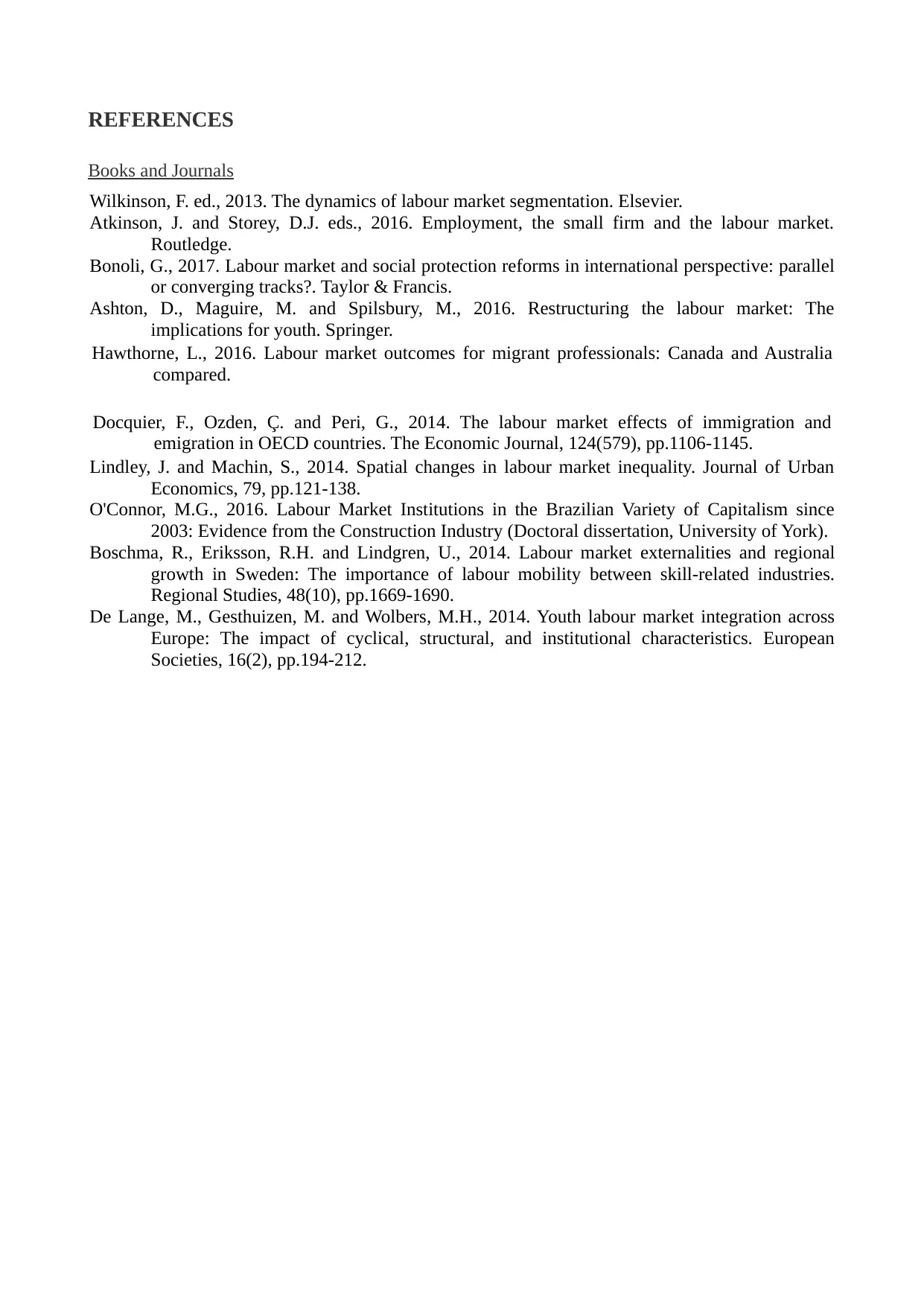
REFERENCES
Books and Journals
Wilkinson, F. ed., 2013. The dynamics of labour market segmentation. Elsevier.
Atkinson, J. and Storey, D.J. eds., 2016. Employment, the small firm and the labour market.
Routledge.
Bonoli, G., 2017. Labour market and social protection reforms in international perspective: parallel
or converging tracks?. Taylor & Francis.
Ashton, D., Maguire, M. and Spilsbury, M., 2016. Restructuring the labour market: The
implications for youth. Springer.
Hawthorne, L., 2016. Labour market outcomes for migrant professionals: Canada and Australia
compared.
Docquier, F., Ozden, Ç. and Peri, G., 2014. The labour market effects of immigration and
emigration in OECD countries. The Economic Journal, 124(579), pp.1106-1145.
Lindley, J. and Machin, S., 2014. Spatial changes in labour market inequality. Journal of Urban
Economics, 79, pp.121-138.
O'Connor, M.G., 2016. Labour Market Institutions in the Brazilian Variety of Capitalism since
2003: Evidence from the Construction Industry (Doctoral dissertation, University of York).
Boschma, R., Eriksson, R.H. and Lindgren, U., 2014. Labour market externalities and regional
growth in Sweden: The importance of labour mobility between skill-related industries.
Regional Studies, 48(10), pp.1669-1690.
De Lange, M., Gesthuizen, M. and Wolbers, M.H., 2014. Youth labour market integration across
Europe: The impact of cyclical, structural, and institutional characteristics. European
Societies, 16(2), pp.194-212.
Books and Journals
Wilkinson, F. ed., 2013. The dynamics of labour market segmentation. Elsevier.
Atkinson, J. and Storey, D.J. eds., 2016. Employment, the small firm and the labour market.
Routledge.
Bonoli, G., 2017. Labour market and social protection reforms in international perspective: parallel
or converging tracks?. Taylor & Francis.
Ashton, D., Maguire, M. and Spilsbury, M., 2016. Restructuring the labour market: The
implications for youth. Springer.
Hawthorne, L., 2016. Labour market outcomes for migrant professionals: Canada and Australia
compared.
Docquier, F., Ozden, Ç. and Peri, G., 2014. The labour market effects of immigration and
emigration in OECD countries. The Economic Journal, 124(579), pp.1106-1145.
Lindley, J. and Machin, S., 2014. Spatial changes in labour market inequality. Journal of Urban
Economics, 79, pp.121-138.
O'Connor, M.G., 2016. Labour Market Institutions in the Brazilian Variety of Capitalism since
2003: Evidence from the Construction Industry (Doctoral dissertation, University of York).
Boschma, R., Eriksson, R.H. and Lindgren, U., 2014. Labour market externalities and regional
growth in Sweden: The importance of labour mobility between skill-related industries.
Regional Studies, 48(10), pp.1669-1690.
De Lange, M., Gesthuizen, M. and Wolbers, M.H., 2014. Youth labour market integration across
Europe: The impact of cyclical, structural, and institutional characteristics. European
Societies, 16(2), pp.194-212.
Paraphrase This Document
Need a fresh take? Get an instant paraphrase of this document with our AI Paraphraser

1 out of 8
Related Documents
Your All-in-One AI-Powered Toolkit for Academic Success.
+13062052269
info@desklib.com
Available 24*7 on WhatsApp / Email
![[object Object]](/_next/static/media/star-bottom.7253800d.svg)
Unlock your academic potential
Copyright © 2020–2025 A2Z Services. All Rights Reserved. Developed and managed by ZUCOL.





